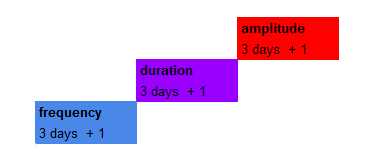 “Man, you bought an expensive train ticket, traveled from Sarreguemines to Lyon . And now you are walking like a duck? “
“Man, you bought an expensive train ticket, traveled from Sarreguemines to Lyon . And now you are walking like a duck? “
My friend laughed at me when I went back from my first marathon, “le Marathon de Beaujolais”,
“ Yes, I did “ I replied, tired to death.
I was happy After 5h30 of running and nobody could remove it from me. I went up to the finish line.
I prove myself I was capable of doing this. This had been a hard long road.
I had come so far after 10 month year of mitigated training
11 months ago, I was unable to ha
At that time I couldn’t even manage to maintain a routine of 1 running session ( 1 km) a week.
Sometimes I was fire up by a motivation wave , went running for 15-20 mn, and then stop for weeks again.
This was far from being consistent and I knew I had to change.
The breakthrough: She told me
If I was serious about executing my goals, I had to improve my productivity in many areas.
It was clear to me consistency wasn’t an alternative anymore, it was mandatory.
“ Which strategy should I use to integrate a different set of new skills”
I didn’t quite know.
But I had noticed something strange over the years: When I exercise, I stop worrying about things I found boring or daunting. I get them done easily without any planning upfront.
So I decided this would be my strategy: building a strong running habit to indirectly perform well in other areas.
This was my first challenge, The first one, a hard one. And I couldn’t back down anymore.
However, there was a set of questions to address.
Problem 1: How can I growth a difficult habit alone
- How should I ramp up to reach a steady-state? in a way that is not too brutal and challenging enough at the same time?
- “Where should I start ?” “What should I focus on”?
- How should we measure how mature the habit is objective?
- how could I evaluate when I could rest?
- How could I know if I was late? If I was in advanced? If it was pushing hard too much?
Problem 2: How can I grow a difficult habit as part of my life?
People talk about habits as if It were the only thing in life.
Sport is just an element of life. We have plenty of other things going on. Work, Studies, researches, parents, visit, friends, personal aspirations.
All these activities do request some bandwidth from a day to day basis. Moreover, they compete and can become distractions that make us fall off track.
How do I integrate my Running routine with limited resources from a lifetime perspective?
- How to monitor the habit of giving the available bandwidth?
- What should I optimize for? Speed or stability?
- Are there some narrow down principles I could remember to give me a good perspective?
- How do I ensure it requires less maintenance to stick
- How to keep the following trough when I fall off track.
Problem 3: How can I grow different difficult habits as part of my life
Communication, Negotiation, spirituality, languages, management, influence, finances, technical skills, are competencies to learn.
I don’t even mention entertain skills like arts, dance, guitar. There is plenty to learn especially if you are multi-passionate.
Some of them can be eliminated temporarily, but others can’t. You need to perform well in the short term while executing the long term goals.
- How to avoid been overwhelmed with too many goals that seem to point in different directions?
- How to decide which direction to take at the appropriate time?
- How do I sort out what to focus on in this direction when I have to sacrifice something?
- Do I have to reinvent the wheel anytime I want to integrate a new skill?
Problem 4: Mainstream ideas provide contradictory advice, and lack precision about How to tailor the integration of habit
- We heard about the 21 days rule and the 63 days rules to
https://www.freeletics.com/en/blog/posts/is-21-days-all-it-takes/
None of them illustrates how to monitor your progress from a day to day basis.
- We are told we should be motivated like hell.
Motivation is crap. It comes and goes and can’t be a foundation of any long term strategy. And when we fail, we blame it on ourselves.
- We are told we should pick up only one at a time for a long period of time.
In real life, our bosses, colleagues, and family have short terms expectations. And moreover, chronic procrastinators are very impatient.
- We are told to learn new things every day.
And yet NOBODY dissects the right level of productivity for the right level of goal.
I was sicked and tired of this lack of accuracy. Ambitious compulsive chronic procrastinators need clarity to execute with ease. There are already struggle with execution, they don’t have the luxury to hesitate and figure things out every time they reach a moment of choice. It is another reason to procrastinate.
That is why I decided to figure things my own.
Since these questions were still opened, I began to conceptualize the notion of minimal path to reach any goal.
So, what is the minimal path to establish and maintain any habit?
How to kickstart a difficult habit from a long term perspective?
Establishing any habit has 3 main stages:
- Stage 1: Triggering: when you go from “Zero” to a “No-brainer” activity.
- Stage 2: Automating: when you operate in a steady-state.
- Stage 3: Consolidating: When you find outside constraints to make you accountable
When you are getting started, focus on the Triggering phase
Part I: The Logical Perspective
Section 1: The Triggering phase
Rule 0: Any habit has 3 main parameters: the frequency, the duration, and the amplitude.
- You can structure your ramp-up process based on these 3 parameters.
- To spend the minimal energy, establish one parameter at a time
Rule 1: It takes exactly 3 consecutive days to install each parameter
This has profound consequences:
- It works on both sides. It also takes 3 consecutive days to de-install a parameter
- You can’t spend 3 consecutive days without performing otherwise the restart will be more painful
- You have only 2 days error-margin no matter what when the unexpected event comes your way (weekends/ parties)
Rule 2: don’t move to another parameter before the previous one is fully triggered
If you fail to establish the frequency, don’t rush to the duration or the amplitude.
No wonder many people fail. From Day 1, They haven’t established the basement but they target the sky. And they finally concluded it is hard.
One step at a time. One parameter at a time.
You can’t skip. There some exceptions to how things overlap but we look at them see later.
Rule 3: The frequency of triggering phase should be at least 2 times the frequency of the automating phase
What is the goal you are planning to reach in autopilot?
If you want to exercise 3 times a week, So start with a triggering frequency 6 times a week.
If you want to exercise 2 times a week, So start with a triggering frequency 4 times a week.
Now let us consider you are aiming for being able to exercise 3 times a week in autopilot (regardless of the duration and number of repetitions ).
 Step 1: spend 3 consecutive days focusing on the frequency and then rest for 1 day
Step 1: spend 3 consecutive days focusing on the frequency and then rest for 1 day
In this phase, duration and Amplitude don’t matter.
So my goal was simple: getting out of my apartment and start running.
If I ran only for 1 min or run over 300 mn. It wasn’t a problem.
Step 2: spend 3 consecutive days to trigger the duration and then take 1-day rest
IN this phase, you direct your focus to the duration.
I went out running and made sure that I ran for at least 10 min. I didn’t care about running 50 meters in 10 min or running 200 m.
It didn’t matter. What matters is that you don’t stop before you reach the minimum duration you set as a commitment.
Step 3: Spend 3 consecutive days to trigger the amplitude
Now I went out to run 1 km. So didn’t care if I did it in 25 min or 45 min.
What matters here is the number of repetitions, not the time you spent.
What matters is you don’t quit on before the number of rep set as commitments.
Nominal and Back up plans
As you can compute, It requires you a minimum of 4 x 3 = 12 days to trigger a difficult habit.
But I can already tell you something. You are going to fail because this is an intense rhythm you are not familiar with.
So What is your margin of error?
That’s where rule 1 we learned upfront comes into play.
“Rule 1: It takes exactly 3 consecutive days to install each parameter “
The generalized version of this rule is ” you can’t fail 3 consecutive times”. Otherwise, you are going to unconsciously trigger the habit of “failing”. And it will be much harder to restart.
If you miss one session during the first mini-cycle of 3 days (for example you don’t exercise on DAy 3), then you have to restart from zero.
And this time it is mandatory to succeed exercising from DAy 4 to day 6 included so you can rest on Day 7.
Same reasoning for the other parameters.
That’s why you have a maximum of 7 days = 1 week to succeed triggering each parameter. As a consequence, you need almost a maximum of 21 days (at max) to trigger the difficult habit.
Examples of triggering programs
 Sport: I don’t have much to say: Sport is hard. Just look at my face 🙂 Water is finished in me
Sport: I don’t have much to say: Sport is hard. Just look at my face 🙂 Water is finished in me
Week 1: succeed go running once a day for 3 consecutive days. Then rest for 1 day.
Week 2: succeed go running once a day, 10 min 3 consecutive days. Then rest for 1 day.
Week 3: succeed running one a day, 10 min, 500 m during 3 consecutive days. Then rest for 1 day.
Meditation: Is it hard? Yesss this is Dam hard too
Week 1: succeed taking a relaxed posture once a day, closing your eyes (ideally), and do nothing apart from directing your attention to events inside (thoughts, feelings, breath, etc). Repeat 3 consecutive days
Week 2: succeed taking a relaxed posture once a day, closing your eyes (ideally) and do nothing apart from directing your attention to events inside (thoughts, feelings, breath, etc) for 5 min. Repeat 3 consecutive days
Week 3: succeed taking a relaxed posture once a day, closing your eyes (ideally) and do nothing apart from directing your attention to events inside (thoughts, feelings, breath, etc). Repeat 3 consecutive days
Writing: Is it hard? oh yes writing is damm hard whether it is for thesis/articles/ etc
Week 1: succeed sitting on a chair and write a few words once a day, for 3 consecutive days
Week 2: succeed sitting on the chair once a day, writing during20 min, for 3 consecutive days
Week 3: succeed sitting on the chair once a day, writing during 20 min, 2 paragraphs, for 3 consecutive days
It is your turn. you can tailor any activity you consider 1) very hard to do 2) mandatory for your career /life.
Part II: The emotional Perspective
Section 1: Overcoming the inner resistance to start triggering (coming soon)
Heudou Tchihikou Aubin
A master chronic procrastinator who chose to execute on his dreams because of frustration and self-criticism






